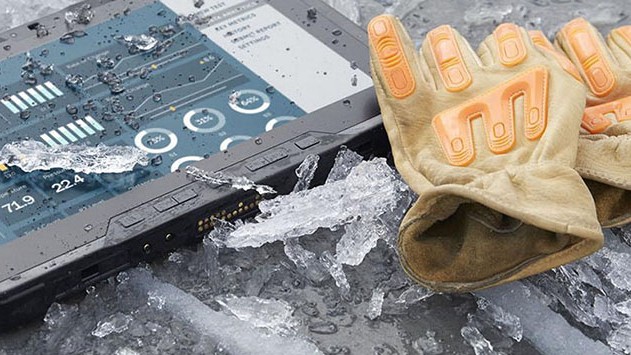Nowadays, it almost seems like consumers have unlimited digital storage space available to them. In 1983, a box of 10 5.25″ floppy disks with 360Kb of space cost $45. Today, a two-terabyte USB drive costs less than $20. Because space is no longer at a premium, the critical question customers face regarding local data storage – whether they are purchasing a medical computer, an industrial panel PC, or a consumer-grade model – is not how much space do I need, but how should I store my data?
In that regard, customers primarily have two choices: Solid-State Drives, also known as SSD, or Hard Disk Drives, also known as HDD. But what’s the difference between the two? Which one is better? What will give me the most bang for my buck? Which will last longer? We’re here to break it all down.
What is a Hard Disk Drive (HDD)?
Article Guide
If you’ve dealt with computers for more than the past five years, the idea of a hard drive should be very familiar to you. First invented in 1956, the hard disk drive has been the standard for personal computer data storage for decades and shows no sign of fading away.
Superficially resembling a vinyl record player at its most basic, a hard disk drive consists of a magnetically sensitive metal platter or disk and a mechanical actuator arm with a read/write head at the end. The platter is divided into concentric circles, known as tracks, and each track is divided into individual sectors.
At the center of the platter is a spindle, which spins at either 5,400 or 7,200 revolutions per second. As the disk spins, the actuator arm positions the read/write head over a given sector on a given track and can both detect or change the direction of the magnetic field of that sector. Each change in the magnetic field direction represents one bit of binary data.
Modern hard disk drives contain multiple platters and actuator arms stacked together and can store many terabytes of data within the same physical space as a deck of cards.
What is a Solid-State Drive (SSD)?
A solid-state drive, also known as a semiconductor storage device, is a form of non-volatile data storage. “Non-volatile” means that, like an HDD, solid-state drives do not lose the data stored on them when their power source is turned off. However, unlike an HDD, solid-state drives use an integrated circuit to store data electronically and do not have any moving parts.
SSDs store data in a series of semiconductor cells. In modern SSDs, each cell can contain up to 4 bits of data. Once data is stored on a cell, it can not be altered, only erased. Thus, when data does need to be rewritten, it is copied and written onto a new cell with the changes, and the data on the original cell is deleted. It is important to note that SSDs do not last forever. Each cell can only be erased a certain number of times before it stops functioning.
Although the technology has existed in some form for over 40 years, solid-state storage did not begin to catch on until flash memory made its commercial debut in 1987. However, even then, it was not widely used in place of HDDs on personal computers until the late 2010s.
Which One is Better?
As it is with so many questions, the answer to this question is “it depends.” There is no one-size-fits-all solution for whether SSDs or HDDs are better. It depends on the end-user’s needs, and a home consumer needs different things out of their computer than in an emergency room or a shipping warehouse would.
HDD v. SSD: Advantages and Disadvantages
The main disadvantage an HDD would have compared to an SSD of the same storage capacity would be its moving parts. Moving parts means that HDDs do not access data as quickly as SSDs. Every time an HDD tries to access a specific piece of data, the actuator arm must physically move to the right location. This takes time. Additionally, moving parts mean that HDDs make more noise than their solid-state counterparts.
Moving parts also mean that HDDs are much easier to break than SSDs. If moved around excessively or dropped, the actuator arm can break off or scratch the platters. The platters themselves can come loose from the spindle. Even if well taken care of and rarely moved, like any machine with mechanical parts, the parts on an HDD will eventually wear down and break on their own.
SSDs, on the other hand, do not require the same kind of careful handling that HDDs need. With no moving parts, there are no physical components to break on an SSD other than the integrated circuit itself. As mentioned above, this does not mean that SSDs do not fail over time. They just fail for a different reason.
Although more fragile and prone to breaking, HDDs have some advantages over SSDs. First, they are a much older and more tested technology than SSDs. They have been the standard for six decades because they are reliable. Second, and most importantly, is cost. Because HDDs are an older and more developed technology, they are significantly cheaper per unit of data when compared to SSDs. For this reason, HDDs come in larger sizes than SSDs.
What’s it all mean?
If you’re a hospital that needs computers that can be wheeled around from patient to patient on a cart, then perhaps a battery-powered medical cart computer with a solid-state drive is the perfect fit for your facility. Or if you’re a small business on a budget that just needs a reliable workstation for your loading dock, maybe a hard disk drive is exactly what you need. If you’re curious about whether hard disk drives or solid-state drives will best suit your needs, contact the experts at Cybernet today!
Why Choose Rugged Tablets over Consumer Tablets
January 12, 2016
As technology continues to play a more integral in the way companies operate, many are now opting to use mobile tablet computers for their business purposes. In fact, According to Quarterly Mobile PC Shipment and…
0 Comments4 Minutes
How Industrial PCs are Shaping Clean Energy
April 21, 2021
The future is green. We’ve been hearing it for years. However, for most of the past five decades, clean energy just has not been economically feasible on a large scale. Despite finite supply and increasing…
0 Comments10 Minutes
Industrial Tablets vs Off-the-Shelf in the Field
November 20, 2017
Since 2010, Apple has seen tremendous success after the corporation released it's first iPad tablet, launching a new market and being the trendsetter in a new line of mobile technology products. As recent as 2016,…
0 Comments8 Minutes
You Can't
Learn from a Pop-up
But we can deliver knowledge to your inbox!
We dive deep in the industry looking for new trends, technology, news, and updates. We're happy to share them with you.
Knowledge, News, and Industry Updates Right in Your Inbox





